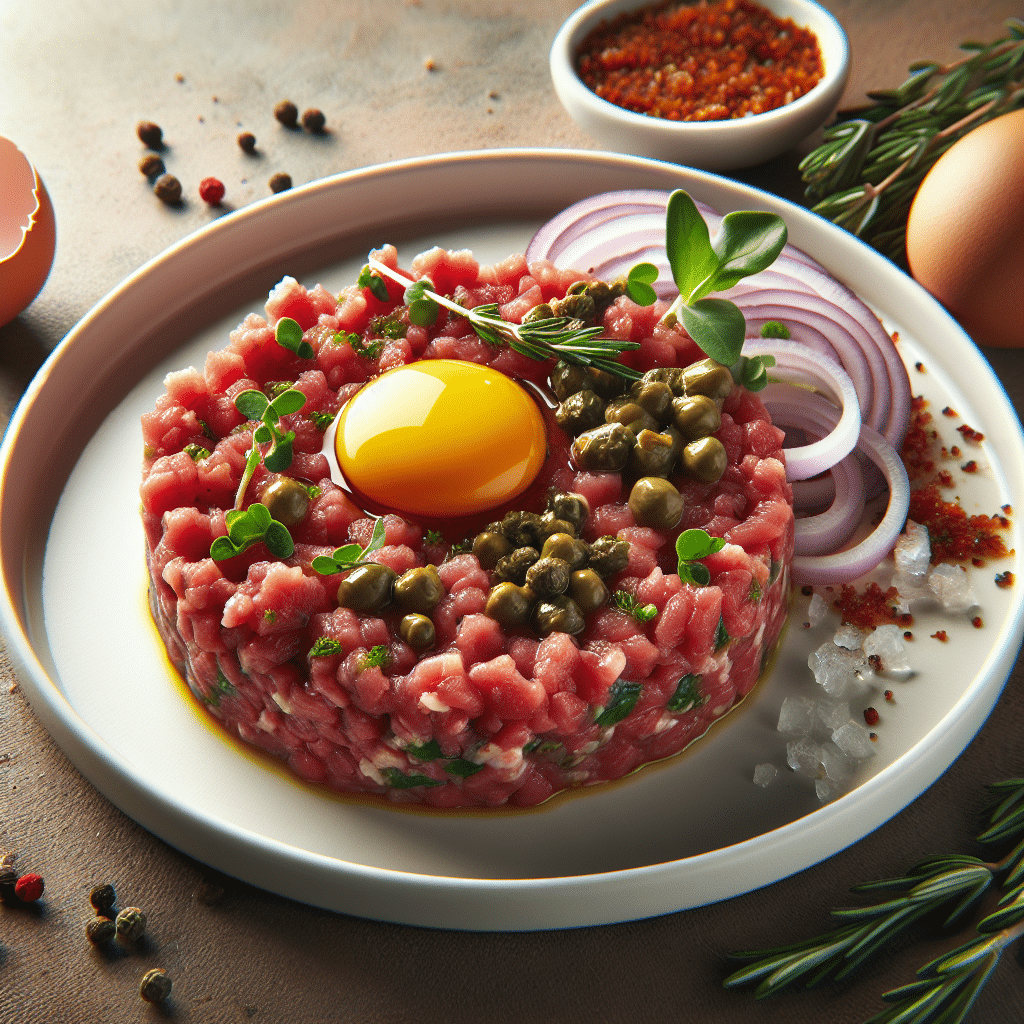Steak tartare is a classic dish made from raw ground or finely chopped beef, typically seasoned with various ingredients to enhance its flavor. Originating from French cuisine, this delicacy often features additions such as egg yolk, capers, onions, and various spices, which are mixed into the meat. Traditionally served cold, steak tartare is often accompanied by sides like toasted bread or potato chips. The quality of the meat is crucial, as freshness is paramount to ensure both safety and taste. As diners savor steak tartare, they experience a combination of rich, savory flavors and a unique texture that differentiates it from cooked meat dishes. This culinary staple not only showcases the beauty of raw ingredients but also reflects a broader cultural appreciation for minimal cooking techniques.
Understanding Steak Tartare
Steak tartare is not merely a dish; it’s a culinary experience that highlights the essence of raw food prep. Rooted in history, its evolution through time reflects changes in dining preferences, food safety practices, and cultural exchanges. Let’s delve deeper into its components, preparation methods, and cultural significance.
The Origins of Steak Tartare
Steak tartare traces its origins back to the 19th century in France, although its lineage may extend further to earlier culinary practices involving raw meat. It is believed that its name is derived from the Tatars, a group of nomadic tribes from Central Asia who are said to have eaten raw meat. As the dish transitioned to European cuisine, various adaptations appeared, incorporating different seasonings and accompaniments while emphasizing the quality of the beef.
Cultural Significance
In modern contexts, steak tartare is often celebrated as a symbol of sophisticated dining. High-end restaurants feature this dish prominently on their menus, appealing to adventurous eaters willing to embrace unconventional flavors. As a dish commonly prepared tableside in some restaurants, it also enhances the dining experience through personal customization, allowing patrons to adjust the seasoning before indulging.
Ingredients and Preparation
The core ingredient in steak tartare is, unsurprisingly, raw beef. The most suitable cuts for this dish are tenderloin or sirloin, as their quality and low fat content produce a superior texture. Beyond the meat itself, several traditional ingredients include:
- Egg Yolks: Often served on top, the yolk adds richness and intertwines beautifully with the meat.
- Capers: These provide a briny contrast that enhances the overall flavor profile.
- Onions: Finely chopped onions, whether shallots or red onions, impart a sharp, savory taste.
- Mustard and Worcestershire Sauce: These are often blended into the mixture to deliver acidity and depth.
- Herbs and Spices: Fresh herbs such as parsley or chives commonly garnish the dish, while salt and pepper are used for seasoning.
Preparation Steps
Preparing steak tartare requires meticulous attention to hygiene and freshness, given the use of raw meat. Here’s a basic step-by-step guide:
- Meat Selection: Choose high-quality beef from a trusted source. Look for bright red color and firm texture.
- Chill the Meat: Refrigerate the beef prior to preparation to make it safer and easier to cut.
- Finely Chop: Use a sharp knife to finely chop the meat into small pieces. Avoid using a food processor, as it alters the texture.
- Mix Ingredients: In a bowl, combine the chopped meat with egg yolk, capers, onions, mustard, Worcestershire sauce, and seasoning. Adjust according to your taste.
- Presentation: Serve on a plate, optionally forming it into a patty, topped with the egg yolk and garnished with herbs. Serve alongside toasted bread or fries.
Health and Safety Considerations
While steak tartare is enjoyed by many, it poses certain health risks if not prepared correctly. The primary concern is the potential presence of harmful bacteria in raw meat, which can lead to foodborne illness. To mitigate these risks:
- Source meat from reputable establishments that follow strict sanitary regulations.
- Ensure freshness—use the meat within 24 hours of purchase.
- Keep the meat refrigerated until ready to serve to prevent bacterial growth.
Some chefs choose to use flash-freezing methods to eliminate potential pathogens, which aligns with best practice guidelines from the U.S. Food and Drug Administration (FDA).
Steak Tartare Variations
Different cultures have interpreted steak tartare, spurring a variety of adaptations that reflect local tastes and available ingredients.
Classic French Version
The traditional French version is often the benchmark for steak tartare, emphasizing the balance of flavors and texture rather than overwhelming condiments.
Italian Tartar
In Italy, a slightly different version known as “carne cruda” features raw meat served alongside truffle oil and fresh herbs to enhance the dish.
African and Asian Influences
Several African cuisines incorporate spices such as chili and lime, adding a zesty kick, while Asian interpretations may integrate soy sauce or sesame oil.
Vegetarian and Vegan Alternatives
With the rise of plant-based diets, several innovative recipes recreate steak tartare using ingredients like finely diced beets or avocado, seasoned to replicate the original dish’s flavor profile.
Conclusion
Steak tartare is not just a meal; it’s a manifestation of cultural culinary artistry that highlights the beauty of raw ingredients. Whether making it at home or enjoying it at a fine dining establishment, steak tartare invites culinary exploration that celebrates flavors, textures, and the rich tradition of raw cuisine. As always, ensure you prioritize meat safety and quality to ensure a delectable experience.
FAQ Section
What type of meat is used for steak tartare?
The best types of meat for steak tartare are traditionally tenderloin or sirloin, as they provide the tenderness and flavor required for this dish. Always choose high-quality, fresh cuts.
Is steak tartare safe to eat?
Steak tartare can be safe to eat if prepared correctly. Ensure the meat is sourced from reputable suppliers, kept at the proper temperatures, and consumed shortly after preparation.
Can I customize my steak tartare?
Yes! Many establishments allow you to customize your steak tartare with different spices, seasonings, and accompaniments. Feel free to adjust to your personal taste preferences.
What should I serve with steak tartare?
Steak tartare is commonly served with toasted bread, potato chips, or a simple salad. Some people enjoy it with side condiments like Dijon mustard or horseradish.
Are there vegetarian alternatives to steak tartare?
Yes, many recipes utilize ingredients such as finely chopped beets, avocados, or mushrooms, seasoned to achieve a similar flavor profile to traditional steak tartare.



